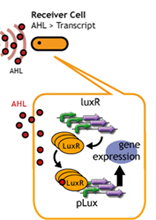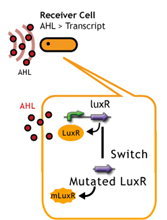Team:Chiba/Receiver experiments
From 2008.igem.org
| Home | The Team | The Project | Parts Submitted to the Registry | Reference | Notebook | Acknowledgements |
|---|
Contents |
Copy number of Receiver Plasmid
English:
日本語:レシーバーのコピーナンバーを減らすことで、GFPが確認できるまでの時間を延長する。
コピーナンバーが少なくなれば、LuxRの合成量は減少する。
LuxRの合成量が減少すれば、AHLを受け取るLuxRは従来より減ってしまう。
そのため、プロモーターの活性化は遅くなり、GFPの発現量は減る。
したがって、コピーナンバーが多いレシーバーより、GFPが確認できるまでの時間を延長させることができる。
(杉山)
LuxR/Plux mutants show
English:
日本語:私たちはmutated Receiverを用いることで、AHL感受性の違う2種類(WTと変異体)のレシーバーを用意し、delay-timeのバリエーションを増やした。
- a greater response to 3OC6HSL[http://authors.library.caltech.edu/5553/ (3)]
- a increase in sensitivity to 3OC12HSL[http://mic.sgmjournals.org/cgi/content/abstract/151/11/3589 (4)].
Receiver experiments details
-->
LuxR mutant (Under construction)
レシーバータンパク質であるLuxRに変異を入れることで応答感度を上下させる(5),(6)
Receiver crosstalk
Design
センダーとレシーバーを元来とは異なる組み合わせにすることによって、thresholdに達する時間を遅くする。(杉山)
Method
Result
Change Receiver's Copy Number
Design
レシーバーのコピーナンバーを減らすことで、thresholdに達するまでの時間を伸ばす。 (小林)
Method
- High Copy Receiver[http://partsregistry.org/Part:BBa_T9002 BBa_T9002 (AHL Reporter)]
- Medium Copy Receiver
High Copy ReceiverとMedium Copy Receiverのディレイタイムはfollowing procedureによってanalyzeした。
- Transformed sender(Ptet-LuxI), high copy receiver(Ptet-LuxR-Plux-GFP-colE1) and Medium copy receiver(Ptet-LuxR-Plux-GFP-p15A) respectively into E coli strains(BD⊿FliC).
- Inoculated them independently in liquid media. Incubated at 37℃ 12h.
- Inoculated again in Fresh liquid media upto about OD600=2 at 37℃
- Washed sender and receivers.
- Mixed them. (Sender:Receiver=1000μL:1000μL)
- Incubated at 30°C.
- Measured intensity of green fluorescence at regular time intervals.(Fluoroskan AscentR FL&Fluoroskan AscentR Thermo ELECTRON CORPORATION)
Result
LuxR mutants
Design
Collins et.al. described the hyper-sensitive variants of luxR to AHL.(Collins, C. H., Arnold, F. H. & Leadbetter, J. R. Directed evolution of Vibrio fischeri LuxR for increased sensitivity to a broad spectrum of acyl-homoserine lactones. Mol. Microbiol. 55, 712–723 (2005))
私たちはmutated Receiverを用いることで、AHL感受性の違う2種類(WTと変異体)のレシーバーを用意し、delay-timeのバリエーションを増やした。 (小林)
Method
- Sender
- [http://partsregistry.org/Part:BBa_S03623 BBa_S03623 (AHL auto inucer)]
- Receivers
- mutant LuxR Receiver
- WT LuxR Receiver ([http://partsregistry.org/Part:BBa_S03623 BBa_T9002 ])
LuxR mutantsとWT LuxRのディレイタイムはfollowing procedureによってanalyzeした。
- Transformed sender (Ptet-luxI), mutant LuxR Receiver (Ptet-mLuxR-Plux-GFP) and WT LuxR Receiver ()into E coli strains (BW⊿FliC)
- Inoculated Sender, WT Receiver (wild type luxR/BW⊿FliC) and mutated Receiver (1point mutation/BW⊿FliC) in liquid media for 12 h at 37℃.
- Inoculated again in liquid media upto about OD600=2 at 37℃
- Washed Senders and receiver.
- Mixed them. (Sender:Receiver=1000μL:1000μL)
- Incubated at 30°C.
- Measured intensity of green fluorescence at regular time intervals.
Result
| Home | The Team | The Project | Parts Submitted to the Registry | Notebook |
|---|
 "
"







